In a previous post I introduced the Logos, and demonstrated how the relationships between the constructs within it constitute the Bible’s shared index of figurative symbolism. We saw how the Logos and the relational overlap which occurs between the constructs within it is what causes biblical symbols to overlap, as symbols can represent every construct that they are directly related to within the Logos simultaneously. Accordingly, we might liken the Logos unto the fountain of eternal spirit logic from which all of the biblical writers drank, causing them to all speak the same figurative code language which unites the 66 books of the biblical canon as one body of literature. As important as this revelation is, it constitutes only one part of a much larger mystery. In this analysis I want to give a very brief introduction to the other side of this mystery that I refer to as the Deuteronomy 30:14 principle. My hope is that introducing this principle will shed additional light on precisely what the Logos is, and demonstrate just how deep the rabbit hole of this mystery goes.
The Deuteronomy 30:14 Principle & Moses’ Farewell Address
As Moses stood in the plain of Moab and addressed the nation of Israel just prior to his death sometime around 1400 BC, he made a very important statement that is (at least in part) reflective of a very important divine mystery that has been kept hidden for thousands of years. That statement was this:
If thou shalt hearken unto the voice of the LORD thy God, to keep his commandments and his statutes which are written in this book of the law, and if thou turn unto the LORD thy God with all thine heart, and with all thy soul. For this commandment which I command thee this day, it is not hidden from thee, neither is it far off. It is not in heaven, that thou shouldest say, Who shall go up for us to heaven, and bring it unto us, that we may hear it, and do it? Neither is it beyond the sea, that thou shouldest say, Who shall go over the sea for us, and bring it unto us, that we may hear it, and do it? But the word is very nigh unto thee, in thy mouth, and in thy heart, that thou mayest do it. (Deuteronomy 30:10-14)
One will note that the last verse of this Scripture (Deuteronomy 30:14) was quoted by the Apostle Paul in his epistle to the Romans (Rom. 10:8). There Paul explains that the Word of which Moses speaks refers to the very same word of faith which they (the Apostles) preach. While this is absolutely true, this verse is simultaneously speaking of something far more specific of which both Paul and even Moses himself were unaware. Indeed, Moses’ words here allude to a divine mystery of gigantic proportions. Given that the allusion to this principle is found in Deuteronomy 30:14, I refer to this principle as the Deuteronomy 30:14 principle.
What is the Deuteronomy 30:14 Principle?
The Deuteronomy 30:14 principle says that the relationships between constructs within the Logos function as unchanging eternal laws which govern and define the perimeters of all figurative language. To return briefly to our previous analogy of the Logos being the fountain of spirit logic from which all of the biblical writers drank—the Deuteronomy 30:14 principle essentially expands that to say that the entire human race unknowingly drinks from this same fountain. Essentially what this means is that human beings speak the figurative code language of the Logos every day as they go about their daily lives–without even realizing they are doing it. This claim is much easier to demonstrate by example than it is to explain with words, and we will therefore show what the Deuteronomy 30:14 is by looking at specific examples which demonstrate the ramifications that this principle has on human language.
A very basic example of the Deuteronomy 30:14 Principle
In two of his epistles, Paul uses the Greek verb ἐξαγοράζω (exagorazzo), which is translated “redeeming” in the KJV, to speak of buying back wasted time (Eph. 5:16; Col. 4:5). This verb is a compound verb which combines the Greek preposition ἐκ (ek (usually rendered “from”, “out of”, “by”, “away from”)); and the Greek verb ἀγοράζω (agorazo), which means “to be in the market place,” or “to buy and sell.”1Paul’s use of this specific verb to speak figuratively of buying back lost time testifies that there exists within the Logos a relational equivalence between the constructs of time and money. The logograph below charts this connection:

Whether we realize it or not, this metaphoric relation that exists between the constructs of time and money within the Logos is the basis of the popular American metaphor: “Time is money.” To put it simply, the relational equivalence under-girding this metaphor existed eternally in heaven long before it ever manifested itself on the earth as a modern English proverb. Essentially, it is as if the Deuteronomy 30:14 principle simply causes that which already exists in heaven to manifest itself upon the earth in our own figurative language (cf. Matt. 6:10; Luke 11:2).
Because of the reality of the Deuteronomy 30:14 principle, any time human beings engage in any kind of figurative language, they are unknowingly speaking according to the relationships that exist between constructs within the Logos. Just for the sake of illustrating this even further, let us expand upon our current and example. Note the following proverb of Solomon:
Labour not to be rich: cease from thine own wisdom. Wilt thou set thine eyes upon that which is not? for riches certainly make themselves wings; they fly away as an eagle toward heaven. (Proverbs 23:4-5)
Through Solomon (who in his day was the wealthiest man to ever set foot upon the earth), the LORD warns against placing one’s trust in wealth and prosperity—which has no power to save or deliver one’s soul (Psalm 49:6-8; 52:7; 62:10; Prov. 23:4; 28:20-22; 1 Tim 6:17). The fleetingness and uncertainty of material wealth is here conveyed through a simile which depicts wealth as sprouting wings and flying away like an eagle. Accordingly, this proverb establishes that there exists within the Logos an association between the construct of money/wealth, and the verb “to fly.” Our logograph thus now looks like this:

Now, the transitive law of equality says that if A = B, and B= C, then A = C. Applying this to our present example–if Time = Money, and there exists a biblically attested association between the construct of “Money” and the verb “to fly“, then this demands that the very same association must also exist between the construct of “Time” and the verb “to fly.” Although I am not aware of any place in the Bible where an association between the construct of time and the verb “to fly” is clearly attested, our logograph demands that this association exists, for as I have stated in a previous post–once a new construct (or in this case–a new associated verb) enters your logograph via a biblically attested relationship to any construct in the logograph, it is automatically related to every other construct (or associated verb, noun, etc.) in the logograph–even if said relationship has not yet been confirmed by Scripture.
Although I cannot think of any place in the Bible where the association between the construct of “time” and the verb “to fly” is clearly and directly implied, the association is nevertheless attested by our figurative language because of the reality of the Deuteronomy 30:14 principle. For in the English language we have a very popular two-word proverb about time, namely: “Time flies.”
Here yet again, the Deuteronomy 30:14 principle causes the spiritual relationships of the Logos which already exist in heaven to manifest themselves upon the earth through the mouth of human beings. And although we did not identify an association between the construct of Time and the verb “to fly” in Scripture, the existence of the proverb “Time flies” confirms the association between the construct of Time and the verb “to fly” within the Logos–for this proverb would not exist upon the earth unless this spiritual relationship was already established in heaven.
Having thus accounted for this association, our updated logograph now looks like this:

Here yet again, we see that the spiritual relationships and associations between constructs and verbs within the Logos are the basis of yet another very common English metaphor about time. The Deuteronomy 30:14 principle is like an invisible law that causes us to unknowingly speak according to the spiritual relations and associations of the Logos.
A more in-depth example of the Deuteronomy 30:14 Principle
In order to better illustrate how the Deuteronomy 30:14 principle works, let us consider a more in-depth example.
In contrast to English and koine Greek, biblical Hebrew doesn’t have two different words for “wind” and “spirit.” Throughout the Old Testament, both of these concepts are referred to by the same noun—ruach. The ancient Hebrews tended to describe abstract concepts by likening them to something in the natural world. It is thus very common in biblical Hebrew for nouns which refer to abstract concepts (like spirit) to be represented by concrete, “this-worldly” nouns (like wind).
In this case, the relationship between these two is fairly obvious and self evident. Wind is invisible, but you know that its there because you can feel it, and you can observe the effect that it has on the trees (which are a commonly used biblical symbol for human beings). In the same way, spirits are invisible, but you know that they exist because you can feel them, and observe the effect that they have on human beings. In any case, the fact that the Hebrew language has one word to refer to both “wind” as well as “spirit” establishes that there exists within the Logos a direct metaphoric relationship between the constructs of wind and spirit.

In one of his epistles, Paul uses wind as a metaphor for any kind of doctrine (Eph. 4:14). The Greek word that he uses here for wind is ἀνέμῳ (animo). What this does is it tells us that there is a direct relationship between the construct of wind and the construct of doctrine (which broadly speaking refers to any kind of teaching, set of dogmatic principles, or organized belief system) in the Logos. Behold our updated logograph:

Now let’s keep going (bear with me, I promise I’m going somewhere with this). In Zechariah 6, the prophet Zechariah sees a vision of the four spirits of the heavens (Zech. 6:1-5). These four spirits are mentioned multiple times throughout the Bible (Jer. 49:36; Ezek. 37:9; Dan. 7:2; 8:8; 11:4; cf. Matt. 24:31; Mar. 13:27; Rev. 7:1), but are usually rendered “the four winds” rather than “the four spirits.” For whatever the reason, this is the only place in the KJV where the translator rendered the Hebrew word “ruachot” as “spirits” instead of “winds.” In the end it really doesn’t matter whether you call them the four winds or the four spirits–as these constructs are relationally interchangeable in the Logos (a fact reflected by the Hebrew language).
This is the only place in the Bible where we are given a visual description of the four winds of the heavens. Zechariah describes them as four chariots–each being pulled by different colored horses. The first chariot is being pulled by red (chesnut) horses, the second chariot is being pulled by black horses, the third chariot is being pulled by white horses, and the fourth chariot is being pulled by grisled and bay horses. This prophetic vision establishes that there exists within the Logos a spiritual relationship between the constructs of both wind and spirit (which are relationally interchangeable), and the construct of horses & chariots.
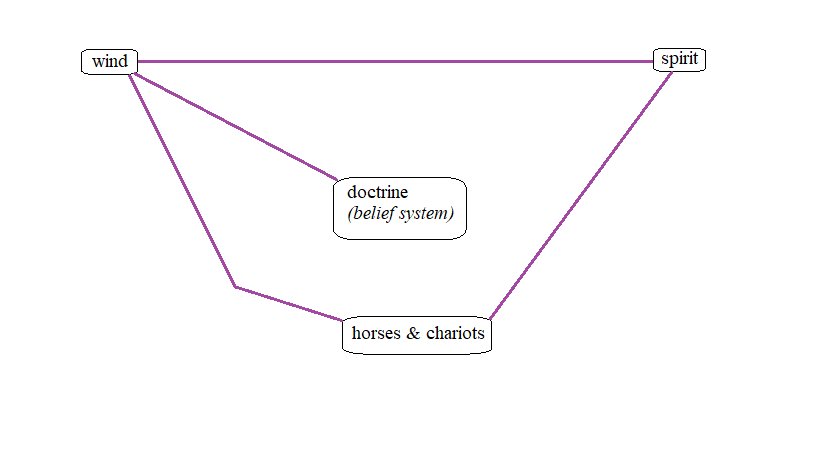
This no doubt probably seems bizarre, as horses & chariots bare no obvious relation to either wind or spirit. The key to understanding this spiritual relationship lies in the fact that these are not natural horses and chariots that the prophet is being shown here, but rather spiritual horses and chariots–like the ones that carried Elijah up to heaven in a fiery whirlwind (2 Kings 2:11).2
According to the transitive law of equality, we know that if the construct of wind is relationally equivalent with the construct of doctrine as well as the construct of horses & chariots within the Logos, then this would seem to indicate that the construct of horses & chariots should also be relationally interchangeable with the construct of doctrine. Perhaps this point will be more clear if worded as an equation:
If wind = doctrine, and wind = horses & chariots, then doctrine = horses & chariots.
If this is indeed the case, then that tells us that horses & chariots may function throughout the Bible as a figurative symbol for doctrines, which broadly speaking refers to any kind of belief system. What is more, we should be able to affirm this fairly easily by closely analyzing the Scriptures where this biblical construct appears.
The use of horses & chariots in the prophecy of Haggai 2:22
There is one particular place in the Bible where the construct of horses & chariots is used that is a dead giveaway, and it is a dead giveaway precisely because of the reality of the Deuteronomy 30:14 principle! Behold:
Speak to Zerubbabel, governor of Judah, saying, I will shake the heavens and the earth; And I will overthrow the throne of kingdoms, and I will destroy the strength of the kingdoms of the heathen; and I will overthrow the chariots, and those that ride in them; and the horses and their riders shall come down, every one by the sword of his brother. In that day, saith the LORD of hosts, will I take thee, O Zerubbabel, my servant, the son of Shealtiel, saith the LORD, and will make thee as a signet: for I have chosen thee, saith the LORD of hosts. (Haggai 2:21-23)
Notice in the above passage how the LORD tells Haggai to tell Zerubbabel that he is going to overthrow the chariots and those that ride in them. This tells us that the verb overthrow is associated with the construct of horses & chariots within the Logos. Our updated logograph now looks like this:

As we are about to see, this pairing of the verb “overthrow” with the construct of horses & chariots is a key hint that affirms that horses & chariots are being used in this prophecy as a figurative symbol for doctrines (pay very close attention to what I am about to do here–as it involves using the Deuteronomy 30:14 principle to figure this out).
It is very important to always pay close attention to what specific verbs and participles are paired with specific constructs that are functioning as figurative symbols in Scripture. Why? Because when any particular verb is attested by Scripture to be associated with a particular biblical construct within the Logos, that same verb is automatically associated with every single construct in that particular construct family, in turn making that verb transposable within the construct family. Accordingly, I refer to this phenomenon as verbal transposition.
Verbal transposition means that verbs and participles that are paired with any particular construct in Scripture can be paired with every other construct that is a member of the same “family” within the Logos. So in this particular example, the law of verbal transposition tells us that the verb “overthrow” (which is paired with the construct of horses & chariots in the prophecy of Haggai 2:23) must be transferable to the construct of doctrine since the two belong to the same family of constructs. If this hypothesis is correct, the Word of God will affirm this association somewhere.
Unfortunately, there will be times that you will not be able to find a single clear instance in the Bible where some specific verb is being used in association with a construct that your logograph tells you it is related to. This is one of those instances. No where in the Bible do we find any clear example of the verb “overthrow” being used in association with the construct of doctrine. In cases such as these where you cannot find a clear affirmation of the link between a specific verb and a particular biblical construct that your logograph implies it is transposable with anywhere in the Written Word, one must turn to the Spoken Word. Herein is the exegetical power of the Deuteronomy 30:14 principle fully realized.
To re-cap, the Deuteronomy 30:14 principle says that the Word is in our mouth, which means that we speak according to the spiritual relationships that exist between constructs within the Logos. For as we noted, the relations between constructs (and their associated verbs) within the Logos constitute eternal laws which govern the way that humans use figurative language. Thus although we have been unable to find any clear example in the Bible where the verb overthrow is used in association with the construct of doctrine, yet because of the Deuteronomy 30:14 principle–we should nevertheless expect to find this verb associated with the construct of doctrine and its equivalents (idea, theory, belief system, etc.) in our own figurative language. Let us consider some examples which demonstrate this very important truth.
Example 1
The following quote is taken from a 2004 PBS documentary. Pay very close attention to how the secular narrator uses the verb overthrow in the following quotation:
Proponents of intelligent design claim that many features of living organisms are too complex to have evolved entirely through the natural process of evolution, as Charles Darwin proposed. Instead, they claim, some aspects of those organisms must have been created, fully-formed, by a so-called “intelligent designer.” And advocates contend intelligent design is a bold, new scientific theory, with the power to overthrow the theory of evolution.3
As we all know, Darwin’s theory of evolution presently stands in Western secular culture as the prevailing scientific model for explaining the origins of life on earth. In the quote above we see that the writer uses the verb “overthrow” in a figurative sense to speak of one belief system potentially displacing another as the prevailing scientific model for explaining life on earth.
Example 2
Here is a similar example. The following quotation is taken from an Encyclopedia article about Relativity:
Relativity, wide-ranging physical theories formed by the German-born physicist Albert Einstein. With his theories of special relativity (1905) and general relativity (1915), Einstein overthrew many assumptions underlying earlier physical theories, redefining in the process the fundamental concepts of space, time, matter, energy, and gravity.4
As with our previous example, the writer of the quote above uses the verb “overthrow” in the past tense to refer to the ramifications that the publication of Albert Einstein’s scientific theories had on the scientific world. The writer uses the verb figuratively to speak of previously held long-standing belief systems (doctrines) and theoretical models being disproved and replaced (“overthrown”) by new and superior ones.
Example 3
Let us consider one last example. The following quote is taken from an article on the discovery of molecular life:
A revolution must be against something. The scientific revolution of the sixteenth and seventeenth centuries overthrew Ptolemaic astronomy and Aristotelean mechanics. The chemical revolution of the late eighteenth century overthrew the phlogiston theory of combustion and the four-element theory of matter. The biochemical revolution of 1770-1970 overthrew the vitalistic belief that the characteristic features of living organisms were manifestations of a special force operating only in living organisms and known variously as pneuma, archeus, Lebenskraft, elan vital, entelechy, ‘biotonic laws’, etc. By discrediting vitalism, the biochemical revolution achieved for biology what the scientific revolution had achieved for physics.5
Once again, the writer of the quote above uses the verb overthrow in the past tense to refer to long-standing scientific models and belief systems (doctrines) being proven wrong and displaced by new and superior ones.
Note that the writer’s repeated figurative use of the word “revolution” here sheds additional light on the connection between horses & chariots and doctrine. Whereas the overthrow of horses and chariots in ancient warfare signified a political revolution, the overthrow of long-standing belief systems by the publication of new and superior knowledge signifies an ideological revolution. Indeed, how many times have you heard someone speak of “a revolutionary idea”? Whether we realize it or not, such common English “figurativisms” are based on these relations that exist between these constructs in the Logos.
While at first glance the relation between horses & chariots with doctrines and belief systems appears to be random and meaningless, it is in fact deeply rooted in sound spiritual logic. Whereas horses & chariots were among the most primary instruments of carnal warfare in the ancient world, so too doctrines and belief systems are the most primary instruments of spiritual warfare (or ideological warfare as it is known on this side of the Enlightenment). Just as the cavalry of rival kingdoms would clash with one another in antiquity, so too the doctrines and belief systems of rival ideologies “clash” with one another in the second heaven. Below is our updated logograph (note that purple lines represent relations confirmed by the Bible (the Written Word), while green lines represent relations confirmed by our spoken language (the Living Word)):
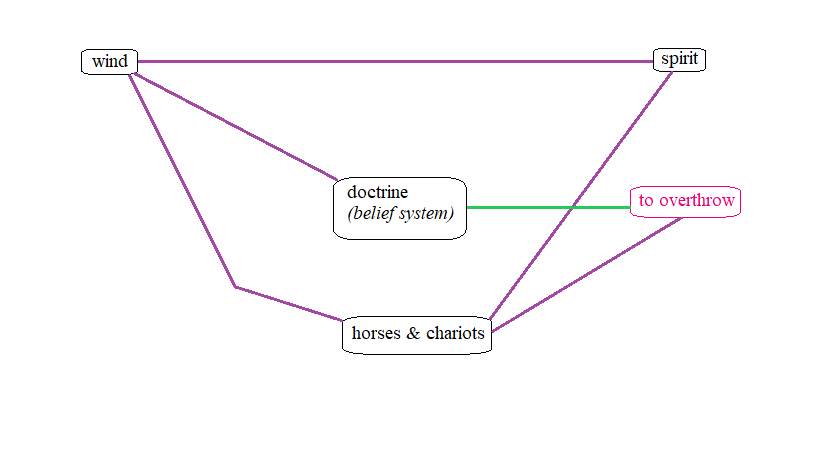
In case you’re wondering what is the meaning of the various colors in our logograph above–black text and boxes signify constructs, while pink text and boxes signify verbs that are used in association with constructs. Likewise purple lines signify relations between constructs and associated verbs that are attested by Scripture, while green lines signify relations between constructs and associated verbs that are attested by our own figurative language (because of the Deuteronomy 30:14 principle).
Armed with this new information, we can now clearly see that Haggai’s prophecy to Zerubbabel (in which God tells Zerubbabel that he will overthrow the horses and chariots and those who ride in them) speaks of a future day when God is going to overthrow every false doctrine and system of belief that the enemy uses to make war against the Word of God. Horses represent the carnal mind, that is—man’s imagination and the power thereof (Ps. 33:17; 147:10; Isa. 31:3).6 Chariots represent diverse doctrines, ideologies, theories, and belief systems which are invention of men. As chariots are driven by horse power, so too doctrines, ideologies, theories, and belief systems are driven by the power of the human intellect. Those who ride in chariots signify those who are “carried about” or “driven away” by Satan’s war chariots of deception and false doctrine (Eph. 4:14; Heb. 13:9; cf. Dan 2:35).
As we can see, the knowledge of the law of verbal transposition can be quite powerful, insomuch as it can be used for the decryption of various biblical symbols when used correctly. As we saw, the pairing of the verb “overthrow” with the constructs of chariots & horses in the prophecy of Haggai 2:23 enabled us to confirm the spiritual relation between the constructs of chariots & horses and doctrine, as we were able to note several secular writers using the exact same verb to speak figuratively of the proverbial overthrow of a currently prevailing belief system or ideology by a rival one that is superior in might. We’ll see more examples of verbal transposition as we continue to develop our logograph.
The association of the verbs “to lie,” “to persuade,” and “to prevail” with the construct of spirit in 1 Kings 22
Note the following passage in which the construct of spirit is used:
So he came to the king. And the king said unto him, Micaiah, shall we go against Ramothgilead to battle, or shall we forbear? And he answered him, Go, and prosper: for the LORD shall deliver it into the hand of the king. And the king said unto him, How many times shall I adjure thee that thou tell me nothing but that which is true in the name of the LORD? And he said, I saw all Israel scattered upon the hills, as sheep that have not a shepherd: and the LORD said, These have no master: let them return every man to his house in peace. And the king of Israel said unto Jehoshaphat, Did I not tell thee that he would prophesy no good concerning me, but evil? And he said, Hear thou therefore the word of the LORD: I saw the LORD sitting on his throne, and all the host of heaven standing by him on his right hand and on his left. And the LORD said, Who shall persuade Ahab, that he may go up and fall at Ramothgilead? And one said on this manner, and another said on that manner. And there came forth a spirit, and stood before the LORD, and said, I will persuade him. And the LORD said unto him, Wherewith? And he said, I will go forth, and I will be a lying spirit in the mouth of all his prophets. And he said, Thou shalt persuade him, and prevail also: go forth, and do so. Now therefore, behold, the LORD hath put a lying spirit in the mouth of all these thy prophets, and the LORD hath spoken evil concerning thee. (1 Kings 22:15-23)
Note that we have a total of three verbs used in association with the construct of spirit, namely: “to lie,”, “to persuade,” and “to prevail.” This yields much new information about the biblical construct of spirit. Let us consider these one by one.
Lying (Participle)
The fact that the participle “lying” is used here as a verbal adjective which modifies the noun “spirit” tells us that spirits are something that can constitute either truth or falsehood. When we combine this with the truth (stated in the above passage) that a spirit is something that can be “in the mouth” of prophets (spokesmen of particular deities), attests that a spirit embodies some sort of doctrine or teaching.
Persuade (Verb)
The lying spirit tells the LORD that he will persuade Ahab to go up and fall at Ramoth-Gilead. This truth that a spirit possesses the ability to persuade a person (such as King Ahab) of the supposed truth of some particular belief or idea–attests yet the more that a spirit embodies some kind of doctrine, teaching, or belief system.7
Here is our updated logograph after our new relations are accounted for:
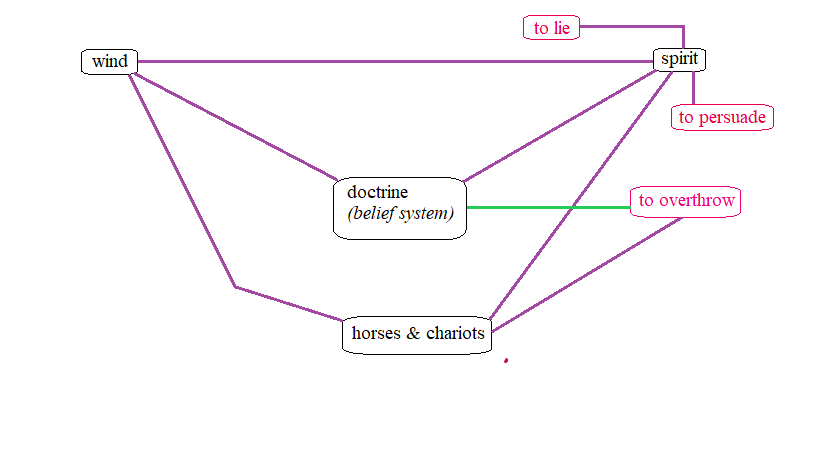
Prevail (Verb)
The third and final verb used in association with the construct of spirit in 1 Kings 22:15-23 is the verb “to prevail.” The LORD tells the lying spirit that he will prevail in persuading Ahab, by which he means that he will be successful. The verb “to prevail” has now entered our logograph on account of its association with the construct of spirit in this passage:
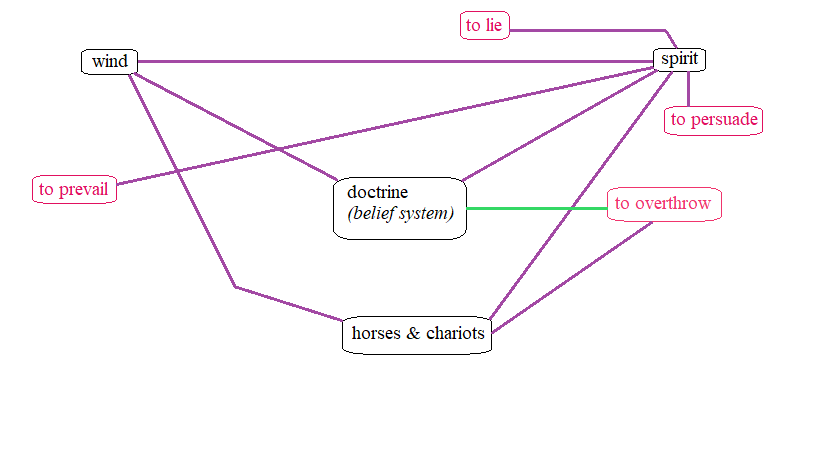
As I stated in my previous post on the Logos, whenever a new construct enters your logograph via a scripturally affirmed relation to another construct already in it, it is automatically related to every other construct within the logograph–even if the relations to those constructs have not yet been identified. This same principle holds true for constructs and associated verbs. As a matter of fact, often times you will find that the spiritual relations between new constructs or new associated verbs and other constructs already in your logograph to be self-evident even before they have been officially identified and affirmed by Scripture.
To give an example, even though we have not yet identified a relation between our new associated verb “to persuade” and the construct of doctrine–we can already see that they are related because a doctrine or belief system is something that certain people hold to be true, and are thus persuaded of. Likewise, horses & chariots were in antiquity the primary instruments of warfare, and the verb “prevail” is tied to the idea of being victorious in battle. Thus the spiritual relation between this new verb and our preexisting construct of horses & chariots is also self-evident.8
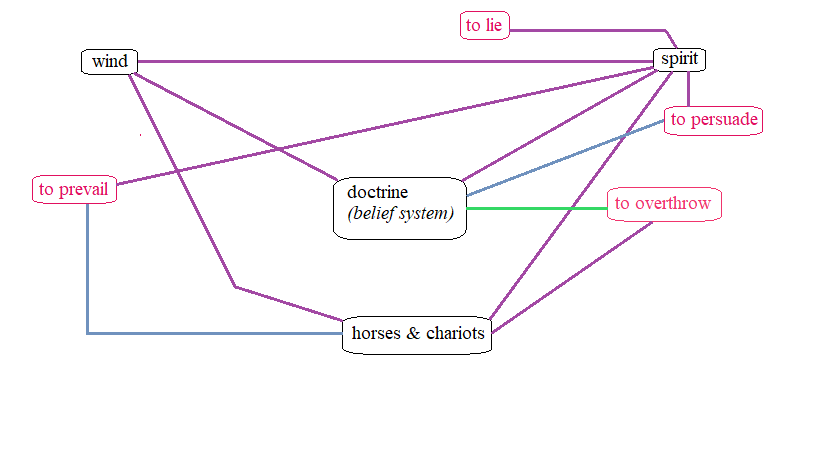
Note that our updated logograph uses gray-blue lines to represent the self-evident relations just described.
Another example of verbal transposition and the Deuteronomy 30:14 principle influencing figurative language
Once again, any time you see a particular verb or participle (e.g. “prevail”) being used with a particular construct (e.g. “spirit”) in Scripture, you can be certain that that particular verb or participle is “transferable” to every construct in the Logos with which that particular construct is relationally interchangeable. As I stated in my previous post on the Logos, I refer to this phenomenon as verbal transposition.
As we saw earlier in the example of the Zerubbabel prophecy of Haggai 2:22, because of the Deuteronomy 30:14 principle—verbal transposition is something that gets reflected in our own spoken language. Let us now consider another example using our updated logograph.
Although no form of the verb “prevail” appears in association with the noun “wind” anywhere in Scripture, it is by combining the participle form of this verb with “winds” that we get our English meteorologic term “prevailing winds,” to refer to winds that blow predominantly from one direction. Once again, we see that our own modern English language abides by the perimeters set forth by these constructional relationships that exists within the Logos. This is another fine example of the Logos influencing figurative language because of the reality of the Deuteronomy 30:14 principle. It is also another fine example of verbal transposition. Here is our updated logograph:

Note that our Logograph above testifies that both spirit and wind are relationally interchangeable with the construct of doctrine. Accordingly, since we have already affirmed that the verb “prevail” is used with these two constructs in both the Bible as well as our own living spoken language, this means that the verb “prevail” should be transferable to the construct of doctrine, in which case we should expect to find this verb associated with this construct in our own living spoken language because of the Deuteronomy 30:14 principle. So let’s stop and think for a second—do we ever use the verb “prevail” to speak of doctrines, teachings, and belief systems in our own figurative speech? The answer is yes we do! Let us consider some examples.
Note the following:
Researchers at Chalmers University of Technology, Sweden, disprove the prevailing theory of how DNA binds itself. It is not, as is generally believed, hydrogen bonds which bind together the two sides of the DNA structure. Instead, water is the key. The discovery opens doors for new understanding in research in medicine and life sciences. The researchers’ findings are presented in the journal PNAs.9
Here we see the participle “prevailing” functioning as a verbal adjective in association with the noun “theory.” A theory refers to an organized body of principles which attempts to explain some particular phenomenon. Accordingly, it falls under the umbrella of the construct of doctrine. When we speak of a “prevailing theory,” we are referring to an organized body of principles which presently stand as the most highly revered and universally accepted explanation for some particular phenomenon in a particular field of knowledge.
Let’s look at another example; note the wording of the following heading of a recently published BBC news article:
Scientists say they have “decisively” overturned the prevailing theory for how planets in our Solar System formed.10
Notice how not only is the participle “prevailing” paired with the word “theory” here, but another verb from our logograph–“overturned” (the identical twin of “overthrew”) is used in association with “prevailing theory.” Thus here we have two verbs and one construct from our logograph that are being used in tandem together by a secular print journalist. This is an ideal example which demonstrates not only how interwoven the constructs within the Logos are, but also the magnitude of influence that the Deuteronomy 30:14 principle has on the figurative language of human beings. Having accounted for these new relations, our updated logograph now looks like this:
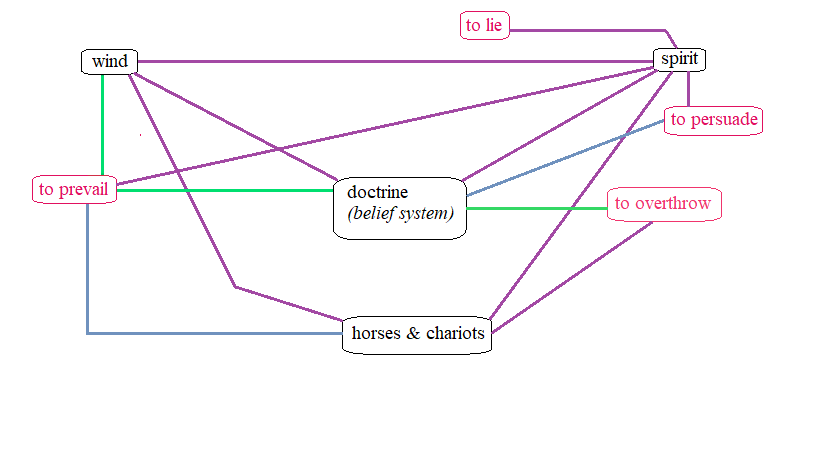
Nouns derived from Associated Verbs
By this point I think we have looked at more than enough examples to clearly demonstrate how the Deuteronomy 30:14 principle causes human beings to unknowingly speak according to the spiritual relations that exist between constructs and their associated verbs within the Logos. There is yet one final example that I wish to look at before we close, as it beautifully illustrates one final very important point to keep in mind about associated verbs. Analyzing this final example will require us to add one additional associated verb to our logograph. Behold the following verses:
And it came to pass in the days of Ahaz the son of Jotham, the son of Uzziah, king of Judah, that Rezin the king of Syria, and Pekah the son of Remaliah, king of Israel, went up toward Jerusalem to war against it, but could not prevail against it. And it was told the house of David, saying, Syria is confederate with Ephraim. And his heart was moved, and the heart of his people, as the trees of the wood are moved with the wind. (Isaiah 7:1-2)
As we noted earlier on in this analysis, trees in the Bible often symbolize human beings (Mark 8:24; cf. Matt. 7:17-19, 12:33; Luke 3:9, 6:43). What is more, wind, as we have already seen, is relationally interchangeable in the Logos with spirit, and consequentially wind is a common biblical symbol for spirit.11
As pertaining to the present discussion, the importance of the above prophecy of Isaiah lies in the fact that it identifies a new associated verb of the constructs of wind & spirit, namely–the verb “to move.” For the analogy used in the prophecy attests that just as wind moves the trees of the forest, so too spirits move human beings. This brings the associated verb “to move” into our logograph:
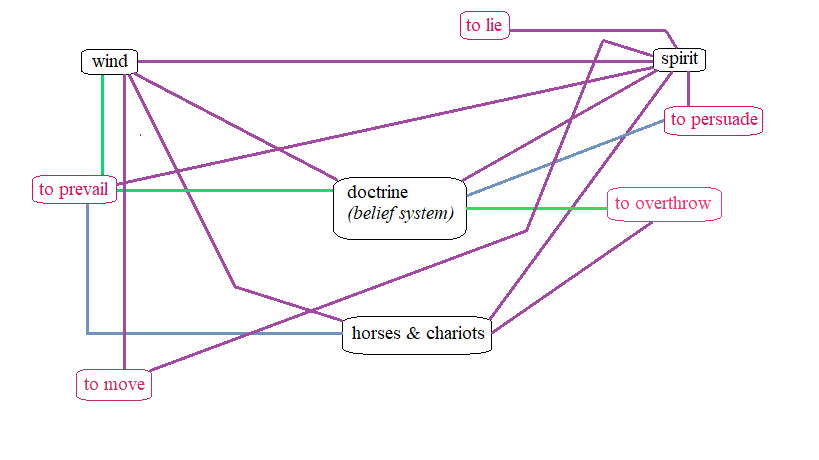
Note that the fact that the verb “to move” is associated with the construct of wind automatically means that it is associated with the construct of spirit also, since (as we have noted previously) the Hebrew word for ruach encompasses both words.12
Example of a noun derived from an associated verb
The final point I want to demonstrate about associated verbs through this example, is that they need not always manifest themselves in our figurative language in verb form. They can also (and often do) manifest as nouns or other parts of speech which are derived from that particular verb. Our present example beautifully illustrates this.
Note that the analogy of Isaiah’s prophecy speaks of not just trees, but more specifically: “the trees of the forest.” What is a forest? It is a collective gathering of trees. Spiritually then, a forest in prophecy would figuratively signify a collective gathering of people. Thus, the implication of Isaiah’s analogy is that just as the wind moves the trees of the forest, so too a spirit can move collective gatherings of people. But what is a spirit?
Our logograph tells us that the construct of spirit is relationally equivalent with the construct of doctrine. Based on this, we can confidently conclude that a spirit is a synonym for some particular doctrine (teaching, theory, belief system, ideology, etc). Thus when we decode Isaiah’s prophecy with the help of our logograph, we see that the implication is that a particular doctrine or belief system has the ability to move collective gatherings of people.
Knowing that the Deuteronomy 30:14 principle causes us to unknowingly prophesy and speak according to the spiritual relations that exists between constructs and their associated verbs within the Logos, can you think of any particular word in the English language that we nonchalantly use on a regular basis to speak of a collective gathering of people united by a shared body of doctrine or belief system? If the answer is no, perhaps the opening paragraph of the Wikipedia article on Black Lives Matter might be of some assistance:
Black Lives Matter (BLM) is a decentralized political and social movement advocating for non-violent civil disobedience in protest against incidents of police brutality and all racially motivated violence against black people.[2][3][4][5][6] The broader movement and its related organizations typically advocate against police violence towards black people as well as for various other policy changes considered to be related to black liberation.[7]
Here is another example from the Wikipedia article on Feminism:
The history of the modern western feminist movement is divided into four “waves”.[27][28][29] The first comprised women’s suffrage movements of the 19th and early-20th centuries, promoting women’s right to vote. The second wave, the women’s liberation movement, began in the 1960s and campaigned for legal and social equality for women. In or around 1992, a third wave was identified, characterized by a focus on individuality and diversity.[30] The fourth wave, from around 2012, used social media to combat sexual harassment, violence against women and rape culture; it is best known for the Me Too movement.[31]
As can be seen, we use the noun “movement” (which derives from the verb “to move”) to speak of a collective body of people who are united by a shared belief in and adherence to some particular body of doctrine or ideology. The Deuteronomy 30:14 principle causes us to do this because the verb “to move” is associated with the construct of spirit in the Logos, which in turn is relationally equivalent with the construct of doctrine. This figurative use of the derived noun movement is signified by a green line between its parent verb (“to move“) and the construct of doctrine on our updated logograph:

What is a Spiritual Movement?
Although most people do not realize it, any kind of doctrine or belief system–whether it be a religion, philosophy, scientific theory, or political ideology, comes directly from the spirit world. As I have stated previously–the spirit world is what we modern humans living on the other side of the Enlightenment refer to as the immaterial world of thoughts and ideas. Although spirits are literal physical entities that exist in the spirit world, we human beings experience them on the earth as thoughts, ideas, doctrines, and belief systems. Thus, whether we realize it or not, any kind of doctrine or subjective belief system is a spirit which ultimately comes from the spirit world. And any spirit other than the spirit of God (who is the one and only spirit of Truth (John 14:17; cf. Deut. 32:4; John 4:24; Eph. 4:4)) is a demonic spirit of deception that comes from the abyss.
Jesus stated that where two or three are gathered together in his name, he is there in the midst of them (Matt. 18:20), by which he means that his Spirit is in their midst. What a lot of people do not realize is that the reverse of this principle is also true, and that whenever unbelievers gather together under the banner of any shared ideology or belief system that is antithetical to the testimony of Jesus Christ (the Holy Bible), then the spirit of Antichrist is in their midst. Thus when we refer to groups like BLM as a “movement“, we are actually prophesying and calling them what they literally are. We do this while being completely ignorant and unaware of the literal spiritual significance of the term. It is the Deuteronomy 30:14 principle which causes us to do this.
The constructs of the Logos are all based on literal spiritual realities.
Thus far I have explained at great length what the Deuteronomy 30:14 principle is, and have clearly demonstrated by example how it influences figurative language, causing us to unknowingly speak according to the spiritual relations of the Logos. Before I close I want to switch gears very briefly and attempt to explain precisely what it is that the constructs of the Logos are based on.
The heaven and the earth
In the beginning God created the heaven and the earth. (Genesis 1:1)
The modern reader has a tendency to read the first verse of the Bible and interpret it to simply mean that at the beginning of time God created his abode and the planet that we inhabit. While this interpretation is not wrong, it is limited in scope. The amazing thing about God is that he can use a single string of words to speak of several specific different things simultaneously–all of which are equally true. On one level, this verse speaks of the creation of what we might describe as two parallel universes, namely–the spirit world (“the heaven”), and the natural world (“the earth”).
The natural world (what the Bible calls “the earth”) encompasses not just the planet earth–but the entire visible universe. Put another way, it encompasses all things belonging to time, space, and matter. Essentially, anything that can experienced through the five senses belongs to the natural realm. Note that everything that is a part of the natural realm is temporal—being subject to the laws of time and space.
The spiritual world is the antithesis of the natural realm. It encompasses all things eternal which cannot be experienced through the five senses. Everything belonging to this realm is incorporeal and intangible, and is experienced on the earth by human beings in the form of thoughts and ideas. A few examples of things that come to us from this realm include: scientific theories, philosophies, religions, political ideologies, music, poetry, etc.
The symbiosis that is constantly occurring between the heaven and the earth
Note that the natural realm was created to function as a figurative “copy” of the spiritual realm, and therefore everything within the natural realm that we can experience through our five senses functions as an imperfect figurative copy of some perfect literal thing that exists eternally in the spiritual realm (Heb. 8:4-5; 9:23-24).13 What is more, just as God ordained reason to rule over passion—so too he ordained the spiritual realm to rule over the natural realm (Gen. 1:14-18). Consequentially, that which occurs in the spirit, eventually gets figuratively reflected in the natural (Matt. 6:10; Luke 11:2). This symbiotic interplay that is constantly taking place between the spiritual and natural worlds is the key to understanding what the constructs (and the relationships that unite them) within the Logos are based on. To illustrate, let us return to our most recent example from the previous section of this analysis. Behold:
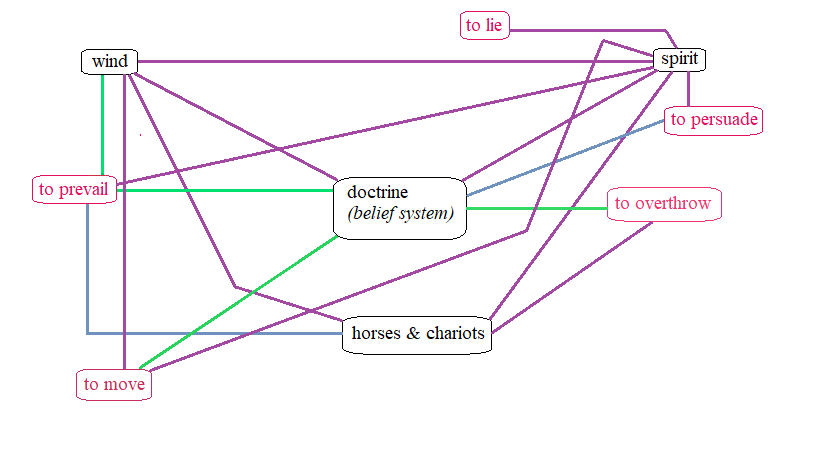
As we have seen, the Deuteronomy 30:14 principle causes us to unknowingly prophesy and speak according to the spiritual relationships between the constructs and their associated words charted in the logograph above. But merely understanding how the Deuteronomy 30:14 principle works doesn’t explain exactly what these constructs are actually based on. This begs the question, are the spiritual relationships between the constructs of the Logos and their associated verbs based on something, or is there some kind of inherent meaning and logic to them them? The answer is yes, and yes.
Example: Spiritual War in the Heavens for control of the Intellectual Atmosphere
As we speak, there is a literal physical war taking place in the spirit world. It is a war between angelic and demonic armies who are fighting one another for dominion and control of what I refer to as the secular intellectual atmosphere. The Bible often refers to this spiritual territory as “the air” (Eph. 2:2; Rev. 9:1), and some Christians refer to it as “the second heaven.”
While we typically use the term “intellectual atmosphere” in a figurative sense to speak of the vast expanse of currently trending societal beliefs, or ideas that are currently “floating around” or “in circulation” (like winds)–this atmosphere exists as a literal geographical territory in the spiritual realm. Essentially, whoever controls this spiritual real estate at any given time controls what doctrines and belief systems permeate the “air” and prevail upon the earth. Accordingly, whatever spiritual forces occupy this spiritual real estate at any given time has control of the culture. This atmosphere is presently controlled by Satan, hence his title: “the prince of the power of the air” (Eph. 2:2).
Because what is literally happening in the heavens gets figuratively reflected upon the earth, this invisible spiritual warfare taking place between God’s army and Satan’s armies in the heavens manifests itself visibly on the earth as what we refer to as ideological warfare. In other words, what we experience on earth as clashes between rival belief systems, is in truth merely an earthly reflection of literal physical clashes between literal armies taking place in the spiritual realm (2 Kings 2:9-11; 2 Kings 6:16b 1:7). For as our logograph testifies–spirits are synonymous with doctrines, ideologies, theories, and belief systems.
This invisible spiritual war of which I speak was witnessed by John the Revelator while in the Spirit:
And there was war in heaven: Michael and his angels fought against the dragon; and the dragon fought and his angels, And prevailed not; neither was their place found any more in heaven. And the great dragon was cast out, that old serpent, called the Devil, and Satan, which deceiveth the whole world: he was cast out into the earth, and his angels were cast out with him. (Rev. 12:7-9)
Notice how John uses the verb “prevailed” here, which we have already noted is connected with all of the constructs in our logograph. This is not coincidental.14 Herein we have scriptural confirmation that the warfare being described here is ideological (spiritual) in nature. The two spiritual armies are fighting here for control of the secular intellectual atmosphere (“the air”), as whoever controls that at any given time dictates what specific doctrines and belief systems prevail as the majority view upon the earth, and accordingly controls the culture. Although this spiritual warfare gets manifested on the earth as ideological warfare between people, these verbal attacks between men of opposing belief systems on the earth are in truth merely figurative shadows of literal physical attacks that are occurring between literal spiritual armies in the heavens. The army of God under the leadership of Joshua is progressively seizing control of this territory from Satan and his host little by little (Exod. 23:30; Deut. 7:22), and one day they are going to succeed in wresting control of the secular intellectual atmosphere completely away from Satan, and he will no longer be able to deceive the world with his war-chariots of false doctrine.
Things that exist in the spirit world become the constructs & associated verbs of the logos, which in turn become the figurative language of human beings upon the earth.
The main point I am trying to bring out in explaining all of this is that the constructs of the Logos and the relationships which bind them together (all of which govern our figurative language)–are all based on literal spiritual things or realities that exist in the heavens. Thus, when we unknowingly speak according to the relationships of the Logos in accordance with the Deuteronomy 30:14 principle, we are unknowingly speaking a figurative code language which is based on these literal spiritual realities. I have created the following diagram to help make this truth more apparent:

As we can see, the figurative code language that we all speak in our every day lives is based on the constructs that exist within the Logos and the relationships between them, and these in turn are based on literal spiritual things or realities that exist in the spirit world. This means that anytime we engage in figurative speech we are unknowingly speaking spiritual mysteries.
Example 1 : The grass is always greener on the other side.
To illustrate this concept using a very simple example, in the English language we have a popular saying: “the grass is always greener on the other side.” We use this saying to figuratively convey the idea that an alternative set of circumstances always seems to be better than one’s present circumstances. Thus we might imagine a miserable 45 year old Dentist who forfeited his dreams of becoming an archeologist to study Dentistry because he deemed it to be the more lucrative and safer option, who now laments his decision and wishes he’d have followed his passion. But this sort of thinking can be very deceptive, as this hypothetical person he has no way of knowing what his life would be like if he’d have chosen to follow his passion. In fact, it is highly likely that he’d have lamented not going into Dentistry for financial security if the shoe was on the other foot. This in turn makes our depressed imaginary person an ideal candidate to receive consolation through the proverb: “the grass is always greener on the other side.”
Yet, although we do not realize it, this “grass is greener” proverb is based on a literal spiritual reality, for the grass in heaven literally is greener than the grass on the earth, as many who have died and gone to heaven (and have come back to talk about it) have testified.15 This literal spiritual truth is built into the constructs of the Logos (all of which are based on literal spiritual realities), and thereby gets reflected in our own figurative language because of the Deuteronomy 30:14 principle.
Example 2: Light at the end of the tunnel
Another very basic example would be the saying “there’s light at the end of the tunnel.” We use this saying to figuratively express the idea that there is hope at the end of a long, dark, and seemingly hopeless situation. In this saying, the darkness of the tunnel functions as a metaphor for hopelessness and despair, and the light at the end of the tunnel functions as a metaphor for hope. Although we do not realize it, this popular English saying is likewise based on a literal spiritual reality.
Numerous people who have physically died and have come back to life have described an eerily similar experience of traveling at a very fast speed through a long dark tunnel after death, at the very end of which was a brilliant bright white light which turned out to be Jesus Christ, who is referred to in the New Testament as “the hope of glory.” (Col. 1:27; cf. Jer. 14:8; 17:3; Acts 28:20). Thus although we do not realize it, this literal spiritual truth concerning what happens to the spirit immediately after death is the basis of this popular English proverb.”16 The Deuteronomy 30:14 principle causes us to unknowingly speak according to the constructional relationships of the Logos, which are founded upon and reflect this great spiritual mystery.
As pertaining to our present example
Now that we have a clear understanding of the way in which the constructs of the Logos are all based on literal spiritual realities which accordingly get reflecting in our figurative speech (because of the Deuteronomy 30:14 principle), let us return and apply this new knowledge to our previous example. Here is the most updated version of our logograph once again:

One will note that all of the constructs, verbs, and associated nouns in the logograph of our most recent example is all war & weather related language. Verbs like “prevail,” “overthrow,” and associated nouns like “revolution“–are words that we typically associate with warfare. Similarly, language such as “wind“, “movement“, and so forth is weather related. The fact that we appear to thus have this clear war & weather theme undergirding the words in our logograph is no coincidence, as this is a reflection of the literal spiritual truths that these constructs and their associated language are based on, namely–the spiritual war taking place in the heavens. Thus when we use language like “prevailing theory,” “a revolutionary idea,” and speak of previous assumptions being “overthrown” (“overturned“, “toppled“, etc.), or certain ideas being “in circulation” or “in the air”–all of this war and weather related imagery is based on something that is literally taking place in the spirit world, namely–the spiritual war between the army of God and the armies of Satan that is taking place in the heavens (hence the use of war language & imagery), which is being fought to determine who controls the secular intellectual atmosphere (hence the use of weather language & imagery).
Another example would be when we use the verb “sway” to refer to changing a person’s opinion on something. Consider the following hypothetical sentence:
In a last ditch effort to sway independent voters, the Biden campaign released a new campaign ad in the swing states of the Rust belt.
Now how the figurative use of the verb “to sway” in this sentence hearkens back to this weather imagery that is attested by our present logograph. We have already affirmed that wind is a figurative symbol of spirit in Scripture, and we have shown that spirits manifest on the earth as some kind of doctrine, teaching, ideology, or belief system. What is more, we also know that trees are a common biblical symbol for people in Scripture (Mark 8:24). Thus, when we speak of trying to sway pubic opinion, we are unknowingly speaking according to this eternal spirit logic of the Logos. The wind (a doctrine or belief system) blows upon the trees (people), and the trees are swayed according to whatever direction the wind is blowing. Spiritually, this signifies the minds of people being persuaded by a powerful doctrine or belief system that is beating upon them. To this agrees the witness of the prophet Isaiah:
And it was told the house of David, saying, Syria is confederate with Ephraim. And his heart was moved, and the heart of his people, as the trees of the wood are moved with the wind. (Isaiah 7:2)
Here we see that Isaiah’s prophecy is describing the hearts of the people being moved (swayed) by a spirit of fear like the trees of a forest are moved (swayed) with the wind (cf. 2 Tim. 1:7). We draw upon this very same metaphor based on the spirit logic of the Logos every time that we speak of the minds of people being “swayed.” This metaphor is rooted in the weather imagery of the Logos that we saw in our logograph.
Summary & Conclusion
In this analysis I have attempted with all of my might to introduce a very important mystery that I refer to as the Deuteronomy 30:14 principle. The mystery of this principle is rooted in a divine proclamation that God made through Moses in his farewell address to the nation of Israel at the close of the fifteenth century BC, as recorded in Deuteronomy 30:14. In layman’s terms, the Deuteronomy 30:14 principle refers to the phenomenon whereby human beings unwittingly speak according to the constructional relationships of the Logos every time they engage in any sort of figurative speech. In this analysis we have looked at two specific examples of varying degrees of complexity which demonstrate how the relationships between the constructs in the Logos are the basis of all figurative language. Specifically, these examples show that the spiritual relations between the constructs of the Logos constitute what we might refer to as eternal laws which govern our figurative speech and define the perimeters thereof. Simply put, although we do not realize we are doing it–any time that we use figurative language we are unknowingly speaking according to the constructional relationships of the Logos. And because the constructs of the Logos are based on literal things and realities that exist eternally in the heavens (the spiritual realm)–every time that we engage in figurative speech we are unknowingly speaking spiritual mysteries.
 Copyright secured by Digiprove © 2021 Zerubbabel
Copyright secured by Digiprove © 2021 Zerubbabel- This Greek verb takes its name from the marketplace, which was called the Agora.
- Indeed, as we will discuss later, there exists in the spiritual realm both angelic as well as demonic armies which are partially made up of horses and chariots of fire (2 Kings 2:11; 6:17; cf. Heb 1:7). These armies are constantly at war with one another in the second heaven, which is synonymous with what we on the earth might refer to as the secular intellectual atmosphere (Rev. 12:7-9).
- “NOVA | Intelligent Design on Trial | Watch the Program | PBS,” PBS, accessed May 21, 2020, https://www.pbs.org/wgbh/nova/programs/ht/qt/3416_01.html
- Kirsi Peltonen et al. “Parental Violence and Adolescent Mental Health,” European Child & Adolescent Psychiatry 19, no. 11 (2010): 813-822, doi: 10.1007/s00787-010-0130-8. https://www.britannica.com/science/relativity
- Vital Forces: The Discovery of the Molecular Basis of Life, preface
- The Hebrew word for “horses” comes from a word that means “to leap” or “to jump.” Herein we have confirmation that horses signify the carnal mind and human imagination, which has a tendency to leap, or jump to conclusions with raging confidence (Job 39:24). What is more, horses are also known for the tremendous speeds at which they are able to run, so much so that they have been used for competitive racing since ancient times. Herein we have additional confirmation—as the carnal mind has a natural tendency to want to race, and the human imagination a tendency to want to “run away” if not kept in check.
- This truth is of course reinforced by additional biblical witnesses. To give just two examples–Jesus referred to his own words as spirit (John 6:63), and the apostle John warned believers that any spirit which confesses that Jesus Christ has not come in the flesh is not of God, and is the spirit of Antichrist (1 John 4:3; 2 John 7).
- The spiritual relation between the verb “to prevail” and the construct of horses & chariots is also implied (though not directly stated) by Scripture (Rev. 12:7-8).
- “Disproving the Prevailing Theory of How DNA Binds Itself | Technology Networks” Technology Networks, January 23, 2019, https://www.technologynetworks.com/genomics/news/disproving-the-prevailing-theory-of-how-dna-binds-itself-324202
- Pallab Ghosh, “New Horizons spacecraft ‘alters theory of planet formation’ – BBC News,” last modified February 13, 2020, https://www.bbc.com/news/science-environment-51295365
- As we explained earlier, the relationship between wind and spirit is self-evident and can be easily understood. Wind is invisible, yet we know when it is present because we can observe the effect that it has on trees. Likewise, spirits are invisible, yet we know when they are present because we can observe the effects they have on human beings. Such is the figurative analogy Isaiah is drawing on in the above prophecy.
- That the verb “to move” is associated with the construct of spirit is also attested in the second verse of the Bible, where we read that “the Spirit of God moved upon the face of the waters.“
- For those of you who are familiar with the writings of Plato, the spiritual realm to which I am referring is what Plato in his dialogues referred to as the realm of the Forms.
- He also uses the verb “deceive” when describing Satan, which is interchangeable with the verb “persuade” in our logograph.
- The NDEs of Jim Woodford, Betty Cone, and Ian McCormick all bears witness of this truth.
- The NDEs of Jim Woodford, Betty Cone, and Ian McCormick all describe traveling through this long tunnel with a bright white light at the end of it immediately after death. There are countless others who describe the very same thing.

Do you have a email I can contact you on.
zerubbabel@beholdthestone.com